Business Analysis for Improving Parking System - Desklib
VerifiedAdded on 2022/10/01
|7
|1143
|343
AI Summary
This requirement analysis report focuses on identifying deficiencies and making improvements in the current parking system adopted by Parramatta City Council. The report covers the problems identified, project scope and vision, stakeholders, functional and non-functional requirements, requirement specification validation and elicitation techniques, and references.
Contribute Materials
Your contribution can guide someone’s learning journey. Share your
documents today.

Business Analysis
1
1
Secure Best Marks with AI Grader
Need help grading? Try our AI Grader for instant feedback on your assignments.
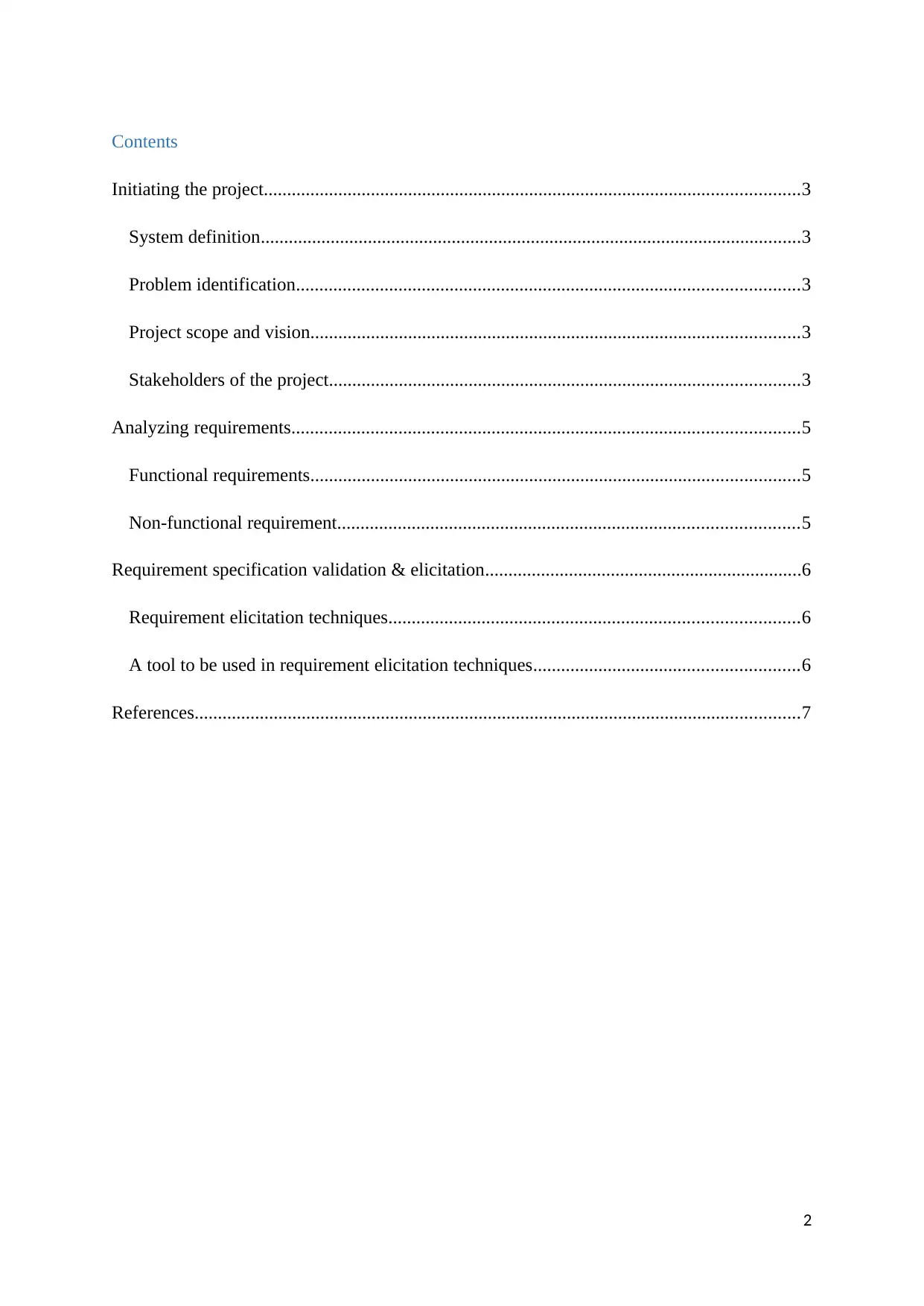
Contents
Initiating the project...................................................................................................................3
System definition....................................................................................................................3
Problem identification............................................................................................................3
Project scope and vision.........................................................................................................3
Stakeholders of the project.....................................................................................................3
Analyzing requirements.............................................................................................................5
Functional requirements.........................................................................................................5
Non-functional requirement...................................................................................................5
Requirement specification validation & elicitation....................................................................6
Requirement elicitation techniques........................................................................................6
A tool to be used in requirement elicitation techniques.........................................................6
References..................................................................................................................................7
2
Initiating the project...................................................................................................................3
System definition....................................................................................................................3
Problem identification............................................................................................................3
Project scope and vision.........................................................................................................3
Stakeholders of the project.....................................................................................................3
Analyzing requirements.............................................................................................................5
Functional requirements.........................................................................................................5
Non-functional requirement...................................................................................................5
Requirement specification validation & elicitation....................................................................6
Requirement elicitation techniques........................................................................................6
A tool to be used in requirement elicitation techniques.........................................................6
References..................................................................................................................................7
2
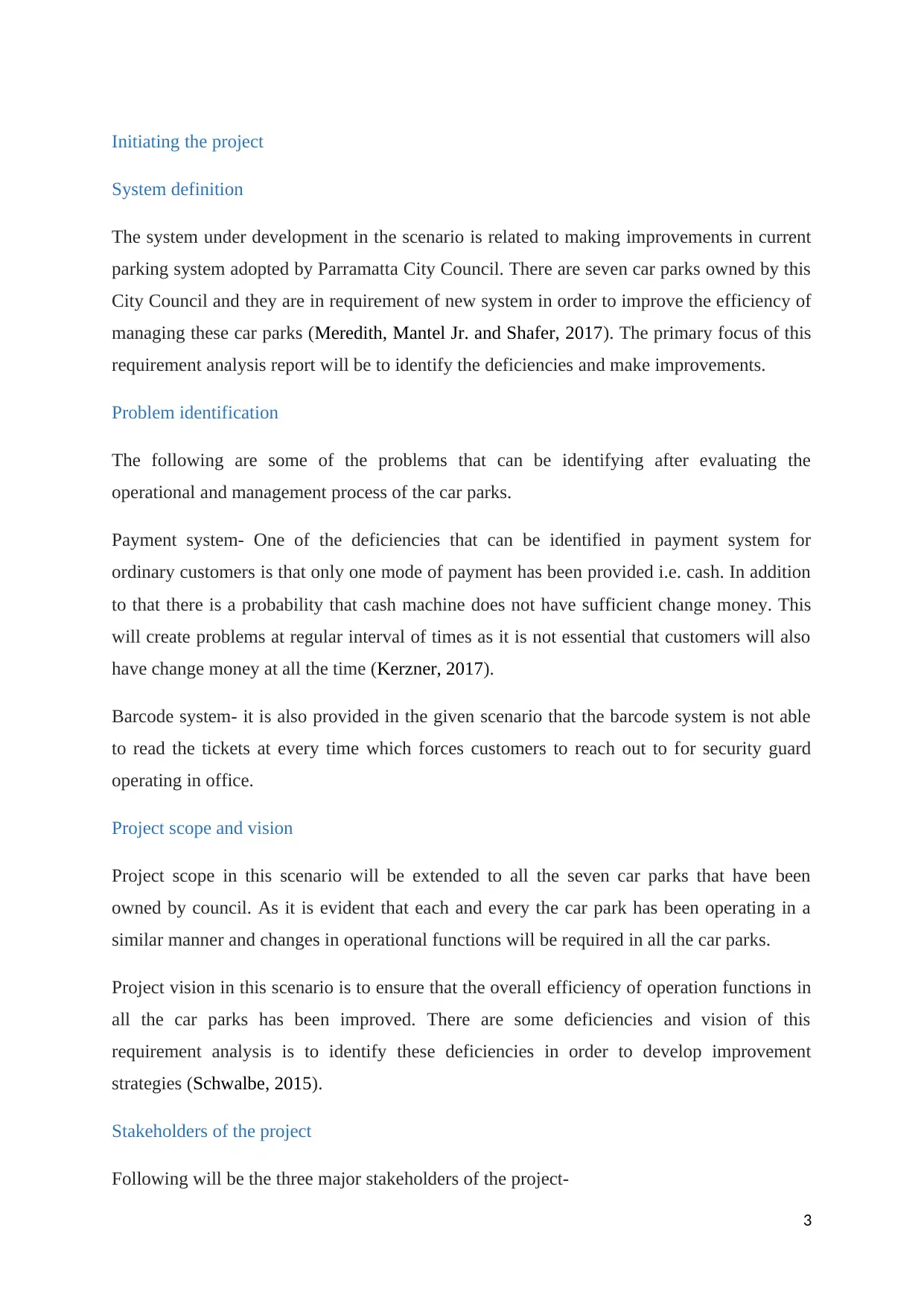
Initiating the project
System definition
The system under development in the scenario is related to making improvements in current
parking system adopted by Parramatta City Council. There are seven car parks owned by this
City Council and they are in requirement of new system in order to improve the efficiency of
managing these car parks (Meredith, Mantel Jr. and Shafer, 2017). The primary focus of this
requirement analysis report will be to identify the deficiencies and make improvements.
Problem identification
The following are some of the problems that can be identifying after evaluating the
operational and management process of the car parks.
Payment system- One of the deficiencies that can be identified in payment system for
ordinary customers is that only one mode of payment has been provided i.e. cash. In addition
to that there is a probability that cash machine does not have sufficient change money. This
will create problems at regular interval of times as it is not essential that customers will also
have change money at all the time (Kerzner, 2017).
Barcode system- it is also provided in the given scenario that the barcode system is not able
to read the tickets at every time which forces customers to reach out to for security guard
operating in office.
Project scope and vision
Project scope in this scenario will be extended to all the seven car parks that have been
owned by council. As it is evident that each and every the car park has been operating in a
similar manner and changes in operational functions will be required in all the car parks.
Project vision in this scenario is to ensure that the overall efficiency of operation functions in
all the car parks has been improved. There are some deficiencies and vision of this
requirement analysis is to identify these deficiencies in order to develop improvement
strategies (Schwalbe, 2015).
Stakeholders of the project
Following will be the three major stakeholders of the project-
3
System definition
The system under development in the scenario is related to making improvements in current
parking system adopted by Parramatta City Council. There are seven car parks owned by this
City Council and they are in requirement of new system in order to improve the efficiency of
managing these car parks (Meredith, Mantel Jr. and Shafer, 2017). The primary focus of this
requirement analysis report will be to identify the deficiencies and make improvements.
Problem identification
The following are some of the problems that can be identifying after evaluating the
operational and management process of the car parks.
Payment system- One of the deficiencies that can be identified in payment system for
ordinary customers is that only one mode of payment has been provided i.e. cash. In addition
to that there is a probability that cash machine does not have sufficient change money. This
will create problems at regular interval of times as it is not essential that customers will also
have change money at all the time (Kerzner, 2017).
Barcode system- it is also provided in the given scenario that the barcode system is not able
to read the tickets at every time which forces customers to reach out to for security guard
operating in office.
Project scope and vision
Project scope in this scenario will be extended to all the seven car parks that have been
owned by council. As it is evident that each and every the car park has been operating in a
similar manner and changes in operational functions will be required in all the car parks.
Project vision in this scenario is to ensure that the overall efficiency of operation functions in
all the car parks has been improved. There are some deficiencies and vision of this
requirement analysis is to identify these deficiencies in order to develop improvement
strategies (Schwalbe, 2015).
Stakeholders of the project
Following will be the three major stakeholders of the project-
3
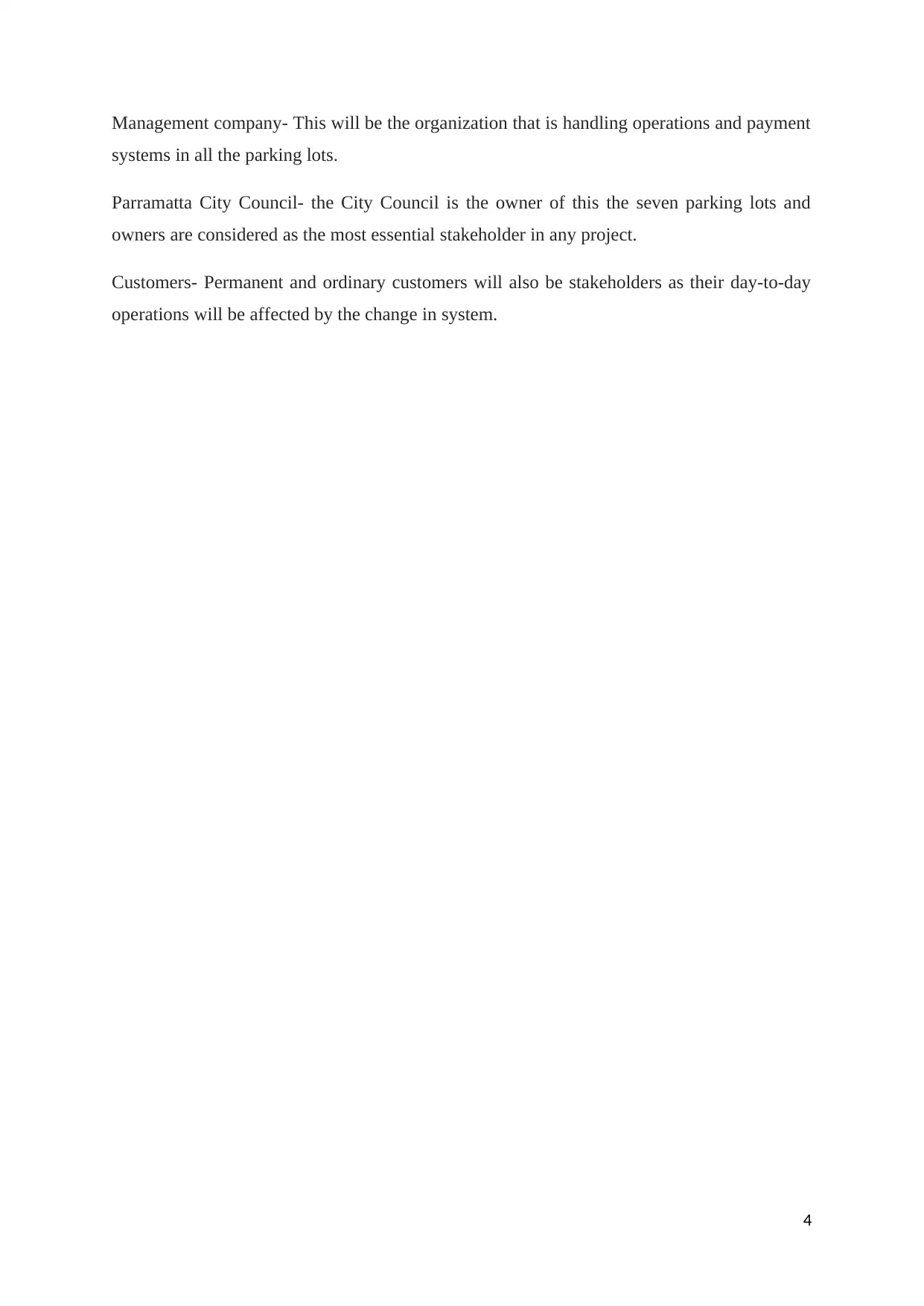
Management company- This will be the organization that is handling operations and payment
systems in all the parking lots.
Parramatta City Council- the City Council is the owner of this the seven parking lots and
owners are considered as the most essential stakeholder in any project.
Customers- Permanent and ordinary customers will also be stakeholders as their day-to-day
operations will be affected by the change in system.
4
systems in all the parking lots.
Parramatta City Council- the City Council is the owner of this the seven parking lots and
owners are considered as the most essential stakeholder in any project.
Customers- Permanent and ordinary customers will also be stakeholders as their day-to-day
operations will be affected by the change in system.
4
Secure Best Marks with AI Grader
Need help grading? Try our AI Grader for instant feedback on your assignments.
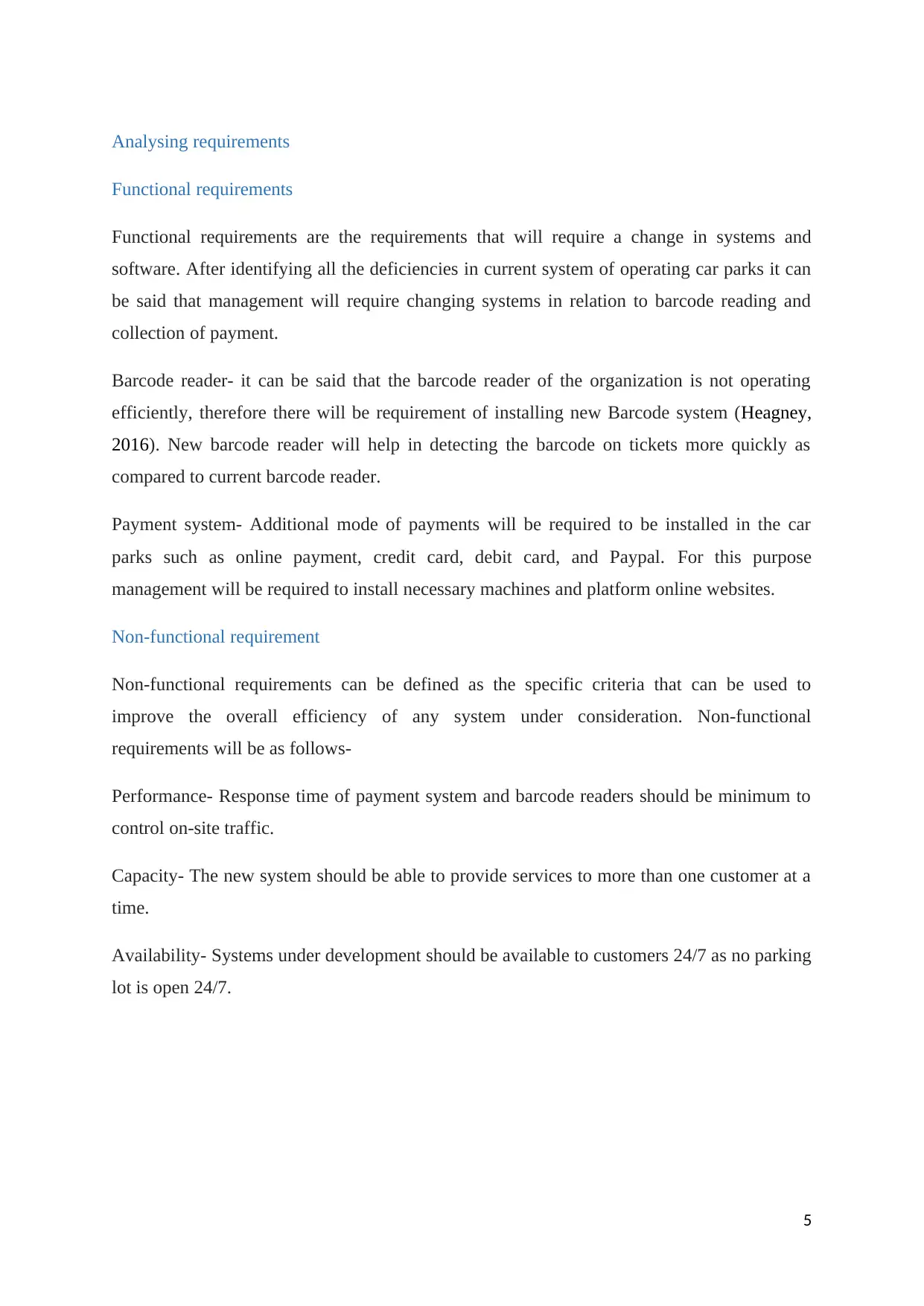
Analysing requirements
Functional requirements
Functional requirements are the requirements that will require a change in systems and
software. After identifying all the deficiencies in current system of operating car parks it can
be said that management will require changing systems in relation to barcode reading and
collection of payment.
Barcode reader- it can be said that the barcode reader of the organization is not operating
efficiently, therefore there will be requirement of installing new Barcode system (Heagney,
2016). New barcode reader will help in detecting the barcode on tickets more quickly as
compared to current barcode reader.
Payment system- Additional mode of payments will be required to be installed in the car
parks such as online payment, credit card, debit card, and Paypal. For this purpose
management will be required to install necessary machines and platform online websites.
Non-functional requirement
Non-functional requirements can be defined as the specific criteria that can be used to
improve the overall efficiency of any system under consideration. Non-functional
requirements will be as follows-
Performance- Response time of payment system and barcode readers should be minimum to
control on-site traffic.
Capacity- The new system should be able to provide services to more than one customer at a
time.
Availability- Systems under development should be available to customers 24/7 as no parking
lot is open 24/7.
5
Functional requirements
Functional requirements are the requirements that will require a change in systems and
software. After identifying all the deficiencies in current system of operating car parks it can
be said that management will require changing systems in relation to barcode reading and
collection of payment.
Barcode reader- it can be said that the barcode reader of the organization is not operating
efficiently, therefore there will be requirement of installing new Barcode system (Heagney,
2016). New barcode reader will help in detecting the barcode on tickets more quickly as
compared to current barcode reader.
Payment system- Additional mode of payments will be required to be installed in the car
parks such as online payment, credit card, debit card, and Paypal. For this purpose
management will be required to install necessary machines and platform online websites.
Non-functional requirement
Non-functional requirements can be defined as the specific criteria that can be used to
improve the overall efficiency of any system under consideration. Non-functional
requirements will be as follows-
Performance- Response time of payment system and barcode readers should be minimum to
control on-site traffic.
Capacity- The new system should be able to provide services to more than one customer at a
time.
Availability- Systems under development should be available to customers 24/7 as no parking
lot is open 24/7.
5
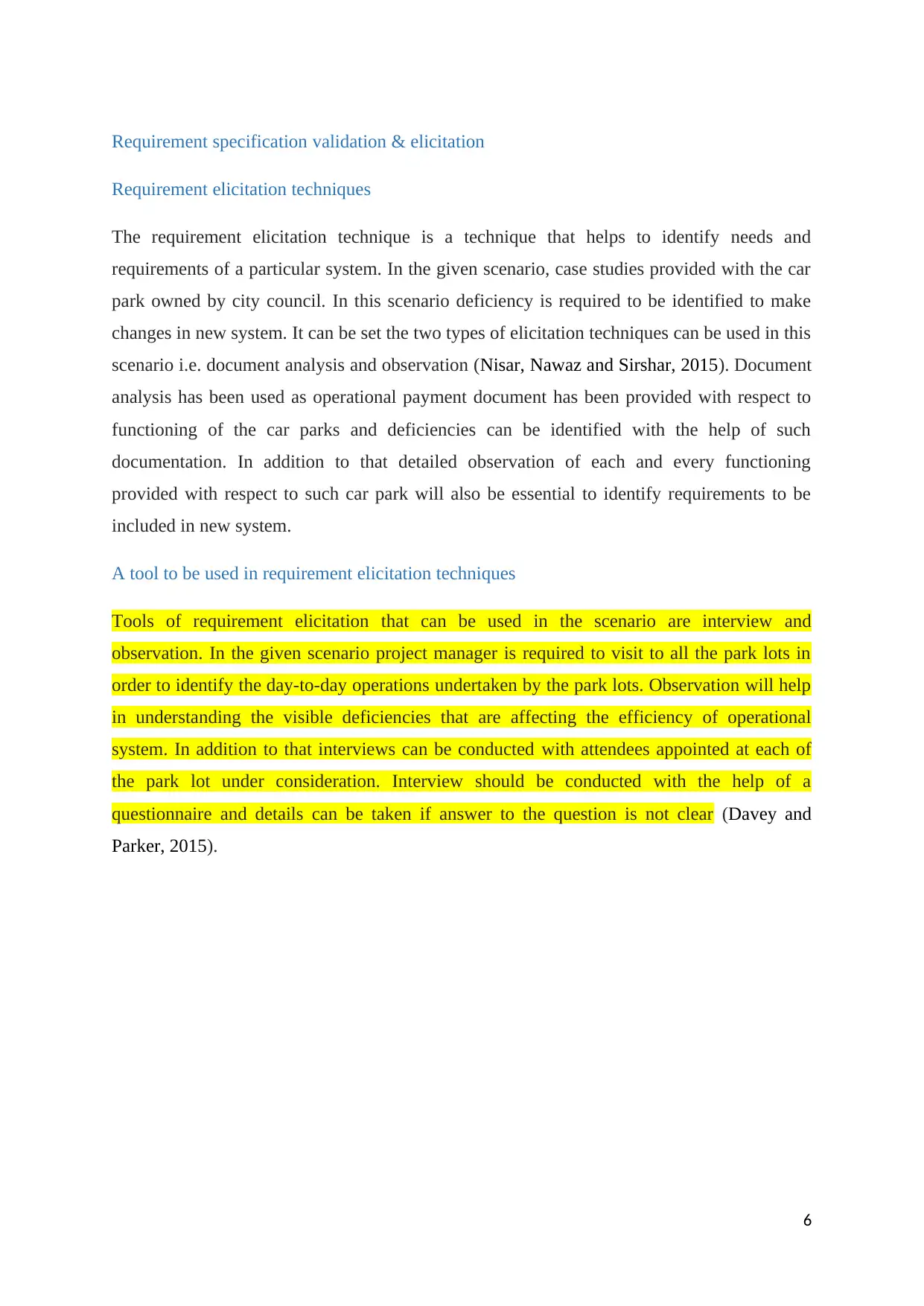
Requirement specification validation & elicitation
Requirement elicitation techniques
The requirement elicitation technique is a technique that helps to identify needs and
requirements of a particular system. In the given scenario, case studies provided with the car
park owned by city council. In this scenario deficiency is required to be identified to make
changes in new system. It can be set the two types of elicitation techniques can be used in this
scenario i.e. document analysis and observation (Nisar, Nawaz and Sirshar, 2015). Document
analysis has been used as operational payment document has been provided with respect to
functioning of the car parks and deficiencies can be identified with the help of such
documentation. In addition to that detailed observation of each and every functioning
provided with respect to such car park will also be essential to identify requirements to be
included in new system.
A tool to be used in requirement elicitation techniques
Tools of requirement elicitation that can be used in the scenario are interview and
observation. In the given scenario project manager is required to visit to all the park lots in
order to identify the day-to-day operations undertaken by the park lots. Observation will help
in understanding the visible deficiencies that are affecting the efficiency of operational
system. In addition to that interviews can be conducted with attendees appointed at each of
the park lot under consideration. Interview should be conducted with the help of a
questionnaire and details can be taken if answer to the question is not clear (Davey and
Parker, 2015).
6
Requirement elicitation techniques
The requirement elicitation technique is a technique that helps to identify needs and
requirements of a particular system. In the given scenario, case studies provided with the car
park owned by city council. In this scenario deficiency is required to be identified to make
changes in new system. It can be set the two types of elicitation techniques can be used in this
scenario i.e. document analysis and observation (Nisar, Nawaz and Sirshar, 2015). Document
analysis has been used as operational payment document has been provided with respect to
functioning of the car parks and deficiencies can be identified with the help of such
documentation. In addition to that detailed observation of each and every functioning
provided with respect to such car park will also be essential to identify requirements to be
included in new system.
A tool to be used in requirement elicitation techniques
Tools of requirement elicitation that can be used in the scenario are interview and
observation. In the given scenario project manager is required to visit to all the park lots in
order to identify the day-to-day operations undertaken by the park lots. Observation will help
in understanding the visible deficiencies that are affecting the efficiency of operational
system. In addition to that interviews can be conducted with attendees appointed at each of
the park lot under consideration. Interview should be conducted with the help of a
questionnaire and details can be taken if answer to the question is not clear (Davey and
Parker, 2015).
6
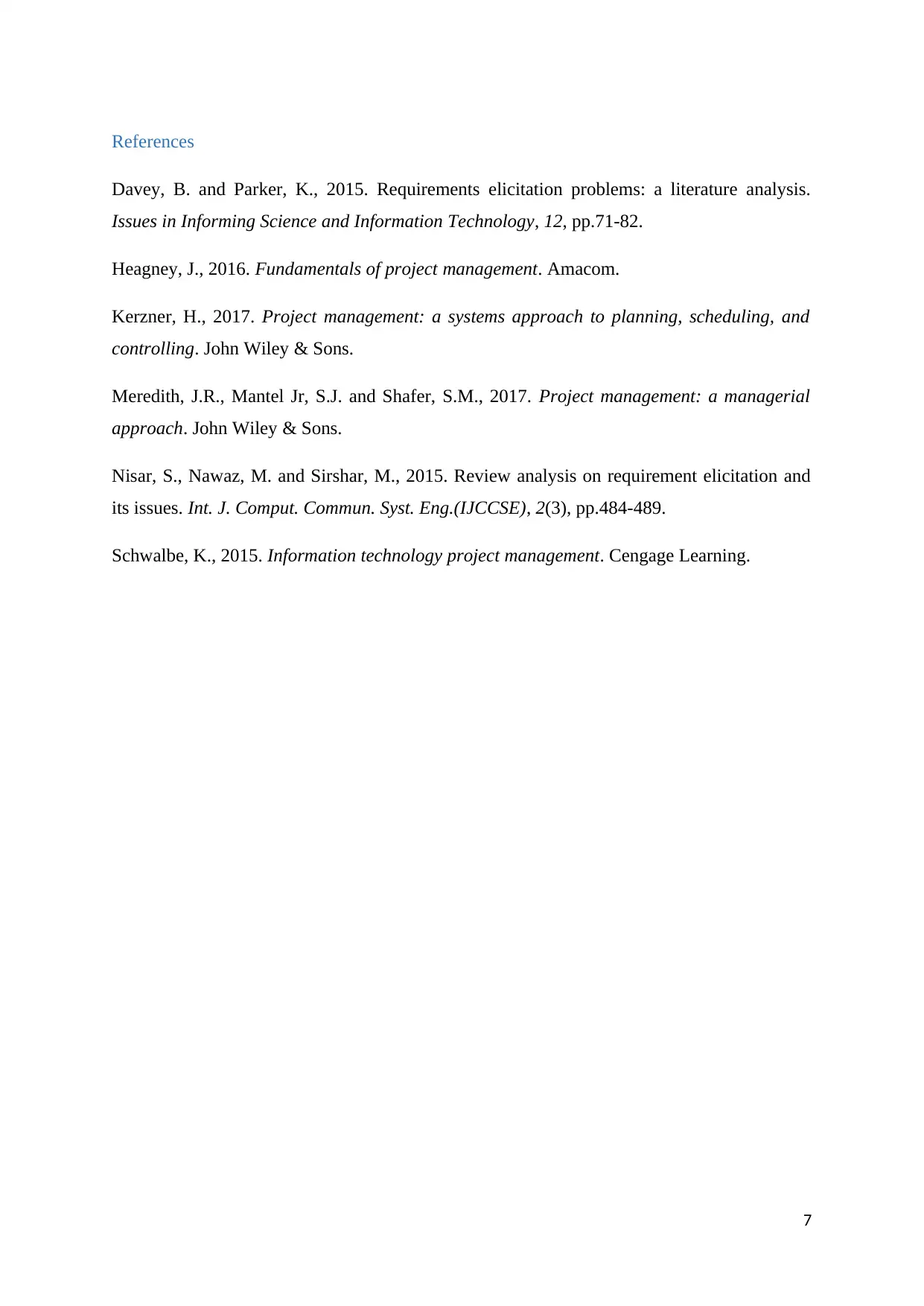
References
Davey, B. and Parker, K., 2015. Requirements elicitation problems: a literature analysis.
Issues in Informing Science and Information Technology, 12, pp.71-82.
Heagney, J., 2016. Fundamentals of project management. Amacom.
Kerzner, H., 2017. Project management: a systems approach to planning, scheduling, and
controlling. John Wiley & Sons.
Meredith, J.R., Mantel Jr, S.J. and Shafer, S.M., 2017. Project management: a managerial
approach. John Wiley & Sons.
Nisar, S., Nawaz, M. and Sirshar, M., 2015. Review analysis on requirement elicitation and
its issues. Int. J. Comput. Commun. Syst. Eng.(IJCCSE), 2(3), pp.484-489.
Schwalbe, K., 2015. Information technology project management. Cengage Learning.
7
Davey, B. and Parker, K., 2015. Requirements elicitation problems: a literature analysis.
Issues in Informing Science and Information Technology, 12, pp.71-82.
Heagney, J., 2016. Fundamentals of project management. Amacom.
Kerzner, H., 2017. Project management: a systems approach to planning, scheduling, and
controlling. John Wiley & Sons.
Meredith, J.R., Mantel Jr, S.J. and Shafer, S.M., 2017. Project management: a managerial
approach. John Wiley & Sons.
Nisar, S., Nawaz, M. and Sirshar, M., 2015. Review analysis on requirement elicitation and
its issues. Int. J. Comput. Commun. Syst. Eng.(IJCCSE), 2(3), pp.484-489.
Schwalbe, K., 2015. Information technology project management. Cengage Learning.
7
1 out of 7
Related Documents
Your All-in-One AI-Powered Toolkit for Academic Success.
+13062052269
info@desklib.com
Available 24*7 on WhatsApp / Email
![[object Object]](/_next/static/media/star-bottom.7253800d.svg)
Unlock your academic potential
© 2024 | Zucol Services PVT LTD | All rights reserved.





